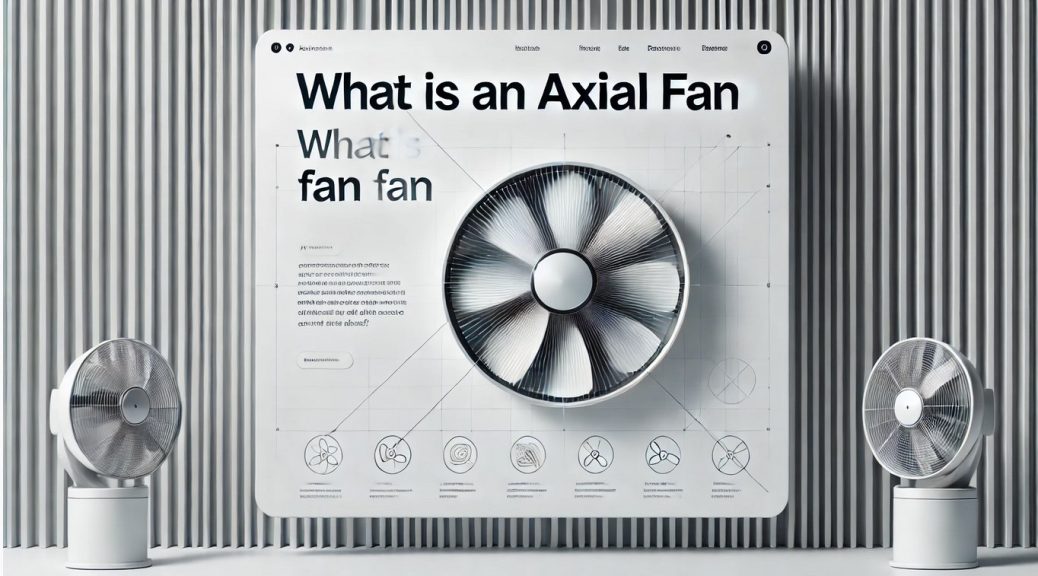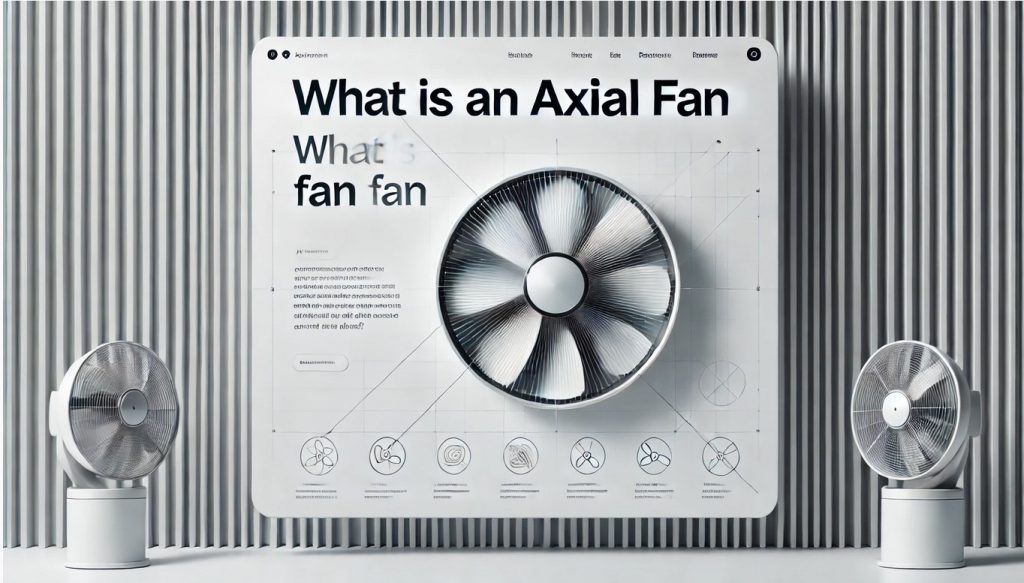
What is an Axial Fan?
Axial fans are one of the most commonly used types of fans in various industrial, commercial, and residential applications. These fans are characterized by their design and the direction in which they move air, making them distinct from other fan types. Axial fans are primarily used for ventilation purposes, offering efficient air circulation and cooling in large spaces. From factories and warehouses to HVAC systems and electronics cooling, axial fans play a crucial role in maintaining airflow and controlling temperature in numerous environments.
What is an Axial Fan?
An axial fan is a type of mechanical fan that moves air along the axis of the fan, which is the direction of the fan blades’ rotation. The airflow is directed parallel to the axis of rotation, unlike centrifugal fans, which expel air at a right angle to the fan’s rotation axis. The primary purpose of an axial fan is to generate airflow and ventilation in large spaces, often used in situations where high airflow at low pressure is required.
Reference: www.oleanfans.com
Key Characteristics of an Axial Fan
- Airflow Direction: The most defining characteristic of an axial fan is its airflow direction. The blades rotate along the axis, pushing air through the fan blades in a parallel direction.
- Fan Blades: Axial fans typically have blades that resemble wings and are often pitched or angled to help move air more effectively.
- High Airflow, Low Pressure: Axial fans are designed to move large volumes of air but usually at relatively low pressures compared to centrifugal fans.
- Design Simplicity: The structure of an axial fan is relatively simple, with fewer components, making it cost-effective and easy to maintain.
Basic Functionality of an Axial Fan
Axial fans function based on the principle of creating airflow by rotating blades, which are powered by an electric motor or another power source. When the blades rotate, they create an area of low pressure behind them and high pressure in front of them. This pressure difference causes air to move, pushing it in a direction parallel to the fan’s axis. The design of the blades and the speed at which they rotate determines the volume of airflow and the efficiency of the fan.
In industrial applications, axial fans are commonly used for cooling purposes, ventilation, and exhaust systems. They are widely found in HVAC systems, electronics cooling, industrial ventilation, and even some applications in agriculture and automotive cooling.
How Does an Axial Fan Work?
The working mechanism of an axial fan is relatively simple but efficient. Here’s how it works:
1. Rotation of the Blades
Axial fans have blades that are angled to facilitate airflow. When powered by a motor, the blades rotate at a constant speed. The motion of the blades displaces the air in the fan’s surrounding environment, generating airflow.
2. Air Movement
As the blades rotate, they push air parallel to the axis of rotation. The blades themselves don’t blow air; instead, they create pressure differences that force the air to move. The blades move air in the direction that matches the axis of the fan, which is why they are called “axial” fans.
3. Pressure Differentials
The fan blades work by creating a low-pressure zone at the rear of the fan and a high-pressure zone at the front. This pressure differential pulls air through the fan, resulting in an increase in airflow. The amount of airflow generated depends on the size of the blades, their pitch, and the speed at which the fan rotates.
4. Flow of Air
Once the air enters the fan, it is directed through the blades and out of the fan. Depending on the fan’s design, the air can either be expelled into a ventilation system, used to cool equipment, or pushed into the atmosphere for general air circulation.
5. Discharge of Air
After the air passes through the blades, it is expelled in the direction parallel to the fan axis. This expelled air may be directed into an exhaust duct or dispersed within the space for cooling or ventilation purposes.
Types of Axial Fans
Axial fans come in various types, each tailored to specific applications or design requirements. The choice of fan type can depend on factors such as airflow volume, size, and operating conditions. Let’s explore the most common types of axial fans:
1. Propeller Fans
Propeller fans are one of the simplest types of axial fans. These fans use blades that resemble propellers and are designed to move large amounts of air with relatively low pressure. They are often used in ventilation systems for spaces like factories, warehouses, or agricultural buildings.
Applications of Propeller Fans:
- Industrial ventilation systems
- Cooling systems for large machines
- Exhaust systems for commercial and residential use
2. Tube Axial Fans
Tube axial fans are similar to propeller fans, but they are enclosed in a cylindrical tube. The casing or tube helps direct airflow in a more controlled manner, providing better performance, particularly in long duct systems. These fans are typically used when the airflow needs to be directed through a system of ducts.
Applications of Tube Axial Fans:
- HVAC systems
- Industrial exhaust systems
- Ventilation for tunnels or mines
3. Vane Axial Fans
Vane axial fans are more advanced than basic tube or propeller fans. In addition to the rotating blades, vane axial fans also feature fixed blades or vanes in the fan housing that direct the airflow more efficiently. This design allows vane axial fans to provide higher pressure compared to basic axial fans.
Applications of Vane Axial Fans:
- High-pressure ventilation applications
- Air conditioning systems
- Large-scale industrial applications requiring higher airflow and pressure
4. Inline Axial Fans
Inline axial fans are designed to be mounted inside a duct system. These fans are compact and efficient, with the ability to move air through long ductwork without significant pressure drop. The fan is typically installed in the middle of a duct to maintain consistent airflow.
Applications of Inline Axial Fans:
- Ventilation systems in buildings
- Cooling systems in industrial settings
- Air filtration systems
Advantages of Axial Fans
Axial fans are widely used for their specific advantages, making them ideal for a variety of applications. Here are some of the key benefits of using an axial fan:
1. High Airflow Capacity
Axial fans are particularly effective in applications that require high airflow but don’t demand a significant increase in pressure. These fans can move large volumes of air, making them ideal for ventilation in large spaces like factories, warehouses, and commercial buildings.
2. Cost-Effective
Due to their simple design and construction, axial fans are often more affordable than other types of fans, such as centrifugal fans. This makes them a popular choice for applications that require efficient yet cost-effective airflow solutions.
3. Low Maintenance
Axial fans have fewer moving parts compared to other fan types, reducing the need for regular maintenance. Their simple design helps reduce the likelihood of breakdowns and extends the overall lifespan of the fan.
4. Energy Efficient
Axial fans are generally energy-efficient because they can move large volumes of air with less power. When designed with energy efficiency in mind, these fans help reduce the overall operating costs of HVAC systems, industrial processes, and other air-moving applications.
5. Versatility
Axial fans are versatile and can be used in a wide range of applications. From HVAC systems to industrial cooling and ventilation, axial fans are adaptable to various environments. Their ability to fit into tight spaces and ductwork makes them ideal for many applications.
6. Low Noise Levels
While they can still produce noise depending on their size and speed, axial fans are generally quieter than other types of fans, especially when operating at lower speeds. This makes them suitable for applications in environments where noise levels need to be minimized.
Applications of Axial Fans
Axial fans are used in a broad range of industries and applications, from simple ventilation to critical cooling systems. Below are some of the most common applications for axial fans:
1. HVAC Systems
Axial fans are extensively used in HVAC (heating, ventilation, and air conditioning) systems to circulate air and maintain airflow across buildings. Whether in residential, commercial, or industrial settings, axial fans ensure that air is distributed efficiently through the ducts and rooms.
2. Industrial Ventilation
In large industrial facilities such as manufacturing plants, warehouses, and mines, axial fans provide ventilation to remove heat, humidity, and fumes, ensuring a safe and comfortable working environment. These fans are essential for controlling indoor air quality and temperature.
3. Cooling Systems
Axial fans are often used in cooling towers, air-conditioning units, and heat exchangers to dissipate heat generated by machinery or industrial processes. Their ability to move large volumes of air allows them to quickly cool equipment and systems.
4. Agricultural Ventilation
In agriculture, axial fans are used to regulate airflow in barns, greenhouses, and animal enclosures. They help maintain the correct temperature and humidity levels for crops and livestock, ensuring optimal growth conditions.
5. Exhaust Systems
In exhaust systems for industrial and commercial buildings, axial fans are used to expel hot, stale, or contaminated air from the building. These fans ensure that air quality remains safe for workers and occupants.
6. Transportation Systems
Axial fans are also used in transportation systems, such as ventilation systems in tunnels and subway stations. They help remove exhaust fumes, heat, and ensure airflow in underground spaces.
Disadvantages of Axial Fans
Despite their many advantages, axial fans also come with some limitations:
1. Low Pressure Generation
While axial fans can move large volumes of air, they typically cannot generate high pressures. For applications requiring high static pressure, centrifugal fans might be more suitable.
2. Limited Efficiency in Duct Systems
In long duct systems or when airflow needs to be controlled precisely, axial fans can be less efficient compared to centrifugal fans, which provide higher pressure and better control.
3. Noise at Higher Speeds
Although axial fans are generally quieter than other fan types, they can produce significant noise at higher speeds or when used in larger applications. This can be an issue in environments where noise reduction is a priority.
